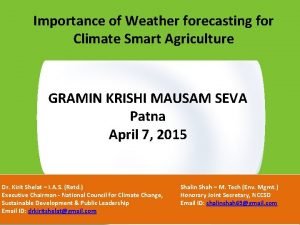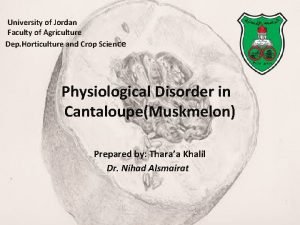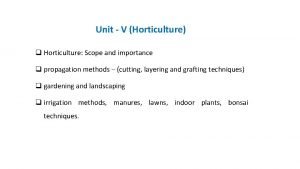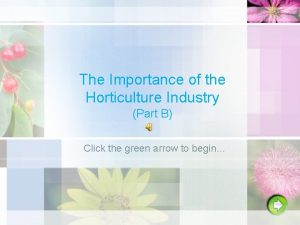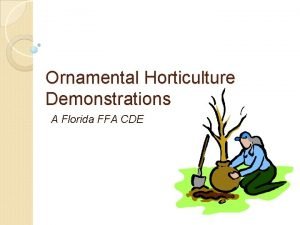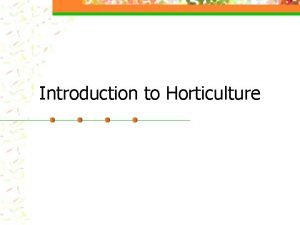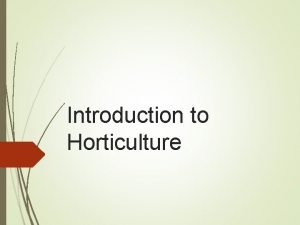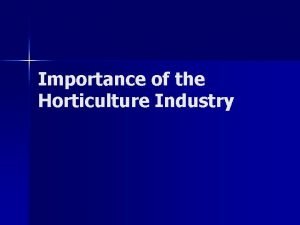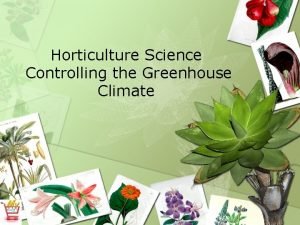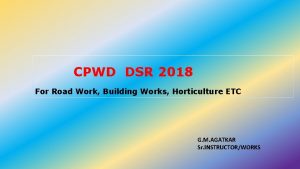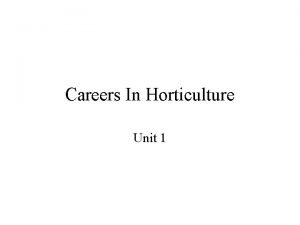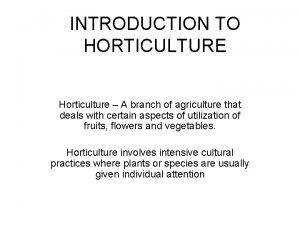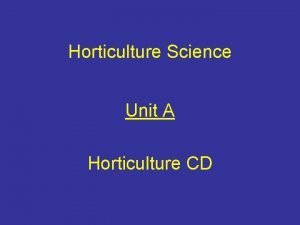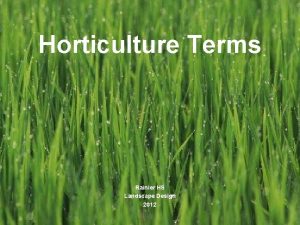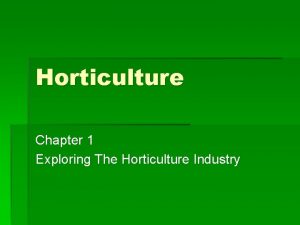Impact of summer weather on Agriculture and Horticulture




























- Slides: 28

Impact of summer weather on Agriculture and Horticulture sectors Dr G. SREENIVAS Principal Scientist (Agro) &Head Agro Climate Research Centre Agricultural Research Institute Professor Jayashankar Telangana State Agricultural University Rajendranagar, Hyderabad

Ø A study by IIT Gandhinagar researchers said that the frequency of severe heat waves in India will rise by 30 times by 2100 under a 2°C warming scenario. Ø The duration of the heat waves, too, could increase 92 -fold under the 2°C scenario, the study says. Ø India’s average annual temperatures could rise by 1 -2°C by 2050. This could go up to 3°C, if no preventive steps are taken in line with the Paris Agreement. By 2050, 600 million people could be living in climate hotspots, particularly in central, northern and north-western India (The World Bank). Ø Extreme weather accounted for 25% of accidental deaths in India between 2001 and 2014. Ø During 2015, a particularly bad year, heat waves killed over 2, 000 people.

Natural disasters Hydro-meteorological disasters Ø Landslides, Ø Avalanches, Ø Droughts, Ø Famines, Ø Extreme temperatures, Ø Heatwaves, Ø Floods, Ø Hurricanes, Ø Forest fires, Ø Windstorms; Ø Waves, Ø Surges and Ø Insect infestation; Geophysical disasters Ø Earthquakes and Ø Volcanic eruptions.

Ø The Intergovernmental Panel on Climate Change (IPCC) has said that rising temperatures could lower India’s farm incomes by 12% in the coming years. Ø The 2018 Economic Survey also said that climate change (including temperature and rain shocks) could reduce annual agricultural incomes by 15 -18% on average, and up to 20 -25% for unirrigated areas. And such problems will only intensify if temperatures keep rising.

Heat wave? Ø Heatwave as a period of abnormally and uncomfortably hot and unusually humid weather, typically lasting two or more days (NOAA). Ø A marked unusual hot weather (maximum, minimum and daily average) over a region persisting at least two consecutive days during the hot period of the year based on local climatological conditions, with thermal conditions recorded above given thresholds (WMO).

What are the factors influence Agricultural activity? Ø Climate, Ø Weather, and Ø Water availability. Weather and climate-related disasters adversely affect agricultural production.

How heatwave impacts agriculture ? Direct impact Ø Physical damage to crops, Ø Animals and Ø Trees Damage caused by the extreme hydro-meteorological events. Indirect impact Ø Loss of potential production owing to disturbed flow of goods and services, Ø Lost production capacities, and Ø Increased costs of production.

Impact of heat waves Ø Tangible § Easily measured in monetary terms Ø Intangible § Anxiety or fear of future natural disasters, § Inconvenience, § Disruption, and § Stress-induced ill health.

Factors for heat build up in plants Very hot and dry winds Ø Rapid water loss in leaves more quickly than roots can take up water, leading to heat injury. Ø Heat damage is most prevalent in hot, sunny, windy days from 11 a. m. to 4 p. m. when transpiration has been reduced. Ø As the plants close stomates to reduce water loss, leaf temperatures will rise even more. Ø In addition, wind can decrease leaf boundary layer resistance to water movement and cause quick dehydration. Ø Wind can also carry large amounts of advected heat.

Dry soil conditions Ø In dry soils, roots produce Abscisic Acid (ABA). Ø This is transported to leaves and signals to stomate guard cells to close. Ø As stomates close, transpiration is reduced. Ø Without water available for transpiration, plants cannot dissipate much of the heat in their tissues. Ø This will cause internal leaf temperatures to rise.

Ø Photosynthesis rapidly decreases above 380 C, so high temperatures will limit yields in many vegetables and fruits. Ø Hot night temperatures Greater cell respiration Limits the amount of sugars and other storage products that can go into fruits and developing seeds

Ø High temperatures also can cause increased developmental disorders in fruiting vegetables -pollen production in beans. Ø As temperatures increase, § pollen production decreases § reduced fruit set, § reduced set, § smaller pods, and § split sets.

Ø Heat injury in plants includes § scalding and scorching of leaves and stems, § sunburn on fruits and stems, § leaf drop, § rapid leaf death, and § reduction in growth. Ø Wilting is the major sign of water loss which can lead to heat damage. Ø Plants often will drop leaves or, in severe cases, will “dry in place” where death is so rapid, abscission layers have not had time to form.

How heatwave impacts crop growth and development? Ø Soil moisture uptake, Ø Root and shoot growth, Ø Photosynthesis, Ø Respiration, Ø Plant water uptake and Ø Final yield

Plant responses to heat stress Morphological symptoms Ø Scorching of leaves and twigs Ø Sunburn on leaves, branches and stems Ø Leaf senescence and abscission Ø Shoot and root growth inhibition Ø Fruit discolouration and damage and reduced yield Ø Reduction in the internodal length Ø Reproductive phases most sensitive to high temperature are gametogenesis (8 -9 before anthesis) and fertilization (1 -3 days after anthesis) in various crop plants (Foolad, 2005).

Three types of sunburn 1. Necrosis: Fruit tissue dies on the sun exposed side of the fruit. Ø For cucumbers fruit skin temperature threshold for sunburn necrosis is 38 -400 C. 2. Browning: cause loss of pigmentation resulting in a yellow, bronze, or brown spot on the sun exposed side of the fruit. Pigments such as chlorophyll, carotenes, and xanthophylls are denatured or destroyed.

3. Photooxidative sunburn: The fruits will become photobleached by the excess light because the fruit is not acclimatized to high light levels, and fruit tissue will die.

Sunscald Ø Hot afternoon sun Ø When green and ripening fruits get too much sun exposure Ø The first symptom is a yellowish-white patch that appears on the side of the fruit facing the sun Ø The area will enlarge as the fruit ripens and become grayish-white § Maintain adequate foliage on the plants § Add additional shade if possible § Grow plants in tomato cages

Large White Spots on Tomatoes Sunscald of tomato, pepper (bell pepper, chile pepper), watermelon, muskmelon, summer squash, and other fruits fruit, occurs when green or ripening fruits are exposed to direct prolonged sunlight, especially during sunny, hot weather. Large, light-colored blistered areas develop on the sides of fruits facing the sun. Management Remove affected fruits immediately and prevent the problem by growing strong, healthy plants with good foliage cover. Control insect and disease problems before they begin to defoliate plants.

Leaf scald Ø Leaf scald occurs most commonly when temperatures are high. Ø crop leaf temperatures may rise to a critical level where plant cells are damaged and they desiccate quickly, leaving the scalded appearance. Ø Upper leaves are the most exposed to radiation from the sun and therefore the most susceptible. Ø Drying winds and low humidity will make scald more severe. Ø Any interruption in transpiration during this period will increase leaf temperature even more and make scald more severe.

High temperature stress in Maize

Ø Plants have 3 major ways in which they dissipate excess heat: 1) long-wave radiation, 2) heat convection into the air and 3) transpiration.

Traits related to high temperature tolerance in rice Ø The impact of high temperatures at night is more devastating than day-time or mean daily temperatures. Ø Booting and flowering are the stages most sensitive to high temperature, which may sometimes lead to complete sterility. Ø Humidity also plays a vital role in increasing the spikelet sterility at increased temperature. Ø Significant variation exists among rice germplasms in response to temperature stress. § Flowering at cooler times of day, § More pollen viability, § Larger anthers, § Longer basal dehiscence

Biochemical processes for thermal tolerance Ø Protection of structural proteins, Ø Enzymes and membranes and Ø Expression of heat shock proteins (hsps) Adaptation measures Ø Replacement of heat-sensitive cultivars with heat-tolerant ones, Ø Adjustment of sowing time, Ø Choice of varieties with a growth duration allowing avoidance of peak stress periods, and Ø Exogenous application of plant hormones

Management practices to minimise sunburn Fruit production losses due to sunburn may be 6 to 30 per cent depending on seasons and the type of fruit. Ø Grow tolerant cultivars, Ø Efficient irrigation, Ø Appropriate canopy management, Ø Cover or intercropping, Ø Over tree sprinkler, Ø Shade netting, Ø Fruit bagging, Ø Suppressants (kaolin or calcium carbonate) and Ø Chemical protectants

Management strategies Farmers are advised to take the following measures to minimize the impact of heat wave. Ø Sowing of summer crops should be completed by 15 th. February to avoid coincidence of flowering with heat wave during the months of April and May. Ø Grow short duration rice varieties to harvest the crop by end of the March. Ø Complete the sowing of rice nurseries by 15 th. December so as to enable to harvest the crop before onset of severe heat wave conditions in the State. Ø Irrigate the crops during early or evening hours only.

Schematic illustration of links between climate change, heat stress occurrence, plant responses to heat stress and farmer’s adaptation measures Stefan and Ewert (2014)

T N A H U O Y K
 Potlaching
Potlaching Human impact on agriculture
Human impact on agriculture Negative impacts of logging
Negative impacts of logging Contingent crop planning slideshare
Contingent crop planning slideshare National conference on agriculture for summer campaign
National conference on agriculture for summer campaign What is the weather like in summer
What is the weather like in summer Spring summer autumn fall
Spring summer autumn fall Station model symbols
Station model symbols Winter tongue twisters
Winter tongue twisters Poems about seasons changing
Poems about seasons changing Cold cool
Cold cool Weather and whether
Weather and whether Heavy weather by weather report
Heavy weather by weather report Capital weather gang weather wall
Capital weather gang weather wall Dsr 2018 vol 2 civil
Dsr 2018 vol 2 civil Dep horticulture
Dep horticulture Objectives of gardening
Objectives of gardening What state
What state Ornamental horticulture demonstrations ideas
Ornamental horticulture demonstrations ideas Horticulture careers list
Horticulture careers list Horticulture buyer jobs
Horticulture buyer jobs Horticulture word
Horticulture word Horticulture history
Horticulture history International horticulture society
International horticulture society International horticultural society
International horticultural society Importance of floriculture
Importance of floriculture Horticulture climate control
Horticulture climate control Dsr 2018 horticulture
Dsr 2018 horticulture Objectives of gardening
Objectives of gardening



